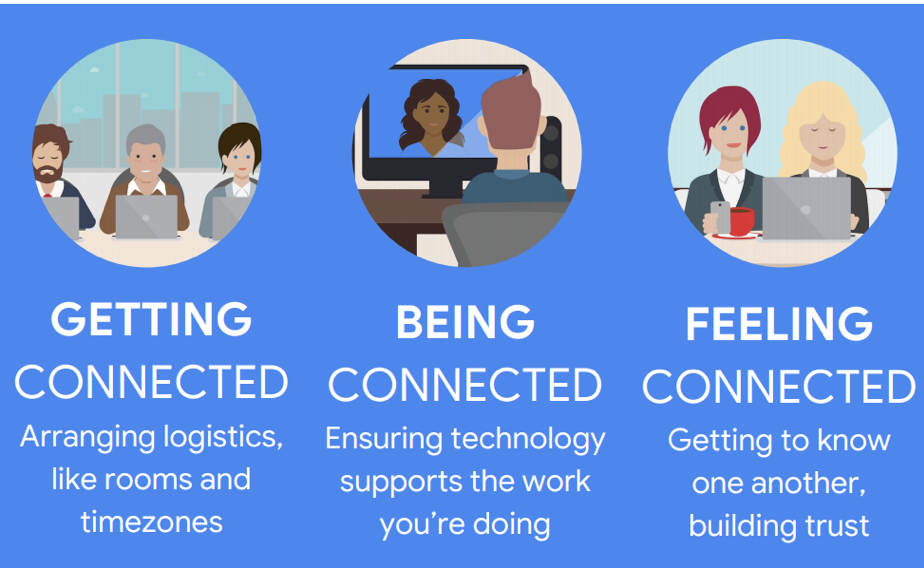‘Men, extroverts, and managers tend to interrupt more and take over during remote team meeting.’
In 2014, Google published the results of ‘project Aristotle’ a large scale in-house study on high performing teams, both remote and face to face (F2F).

This quote above echoes our vision at Nomadic IBP, that remote teamwork should not be seen as ‘second best’ after F2F teamwork. Managed well, remote teams can outperform face to face teams.
Let’s take a look at what the researchers at Google found.
The #1 thing that matters is how people treat each other. ‘Psychological safety’ is strongly related to team results.
What does that mean? Team members feel safe, when:
- Everyone talks during meetings (equal participation)
- Team members listen to each other (listening skills
- Team members pay attention (engagement and respect)
To me, that is the most significant finding and consistent with what we teach people in our programmes on remote working. It sounds simple but in reality it is surprisingly challenging.
The rest of the Aristotle research findings can be summarized in these 3 steps:
1. Getting connected
In the end, it’s human working with humans. Technology connects people; strong relationships make people feel connected.
First, the technology must be flawless and this always takes some preparation. Nothing as disruptive to building working relationships as an echo on the line or strange background noises – we’ve all been here: https://www.youtube.com/watch?v=xjUSjlGPp0k (the conference call from hell)
Rotating time zones
How is the time slot set? The dominant group tends to get the best time slot, usually within normal working hours. Often that subgroup consists of the people based in HQ or the most senior person in the team; smaller or remote units get ‘punished’.
The burden and discomfort of having to join a meeting outside of normal working hours should be rotated. More about this in my blog about time zone rotation.
2. Being connected
To see or not to see
Google’s report suggests using video over plain voice conferences. They argue that an important element of psychological safety is to be attuned to each other’s non-verbal communication, including body language.
At Nomadic IBP, we carefully select technology to match the task and the group at hand. When relationship building is important, video equipment can be useful, but there are many instances when audio only is preferred. For instance, when complex documents are being shared on the screen, or simply when some team members have limited bandwidth.
Inclusion
The Google researchers found that men, extroverts, and managers tend to interrupt more and take over. If certain people speak (much) more than others, collective intelligence of the team declined.
In high performing teams, there is equality in distribution of conversational turn-taking. A fancy way of saying that everyone is included in the team meeting and that distribution of air time is more or less equal.
Clear norms or ‘virtual etiquette’
Clear rules avoid confusion, unnecessary friction and misunderstandings — everyone knows what to expect from others (Gustavo Razzetti, Liberationist.org). The entire team should help design the norms. Remote working is all about collaboration — everyone should play an active role.
3. Feeling connected: build relationships
Building relationships over distance and time zones is not obvious. It’s’ a process that needs to be actively manage and facilitated. Have you noticed, how in virtual meetings, the tendency is to ‘get down to business’ immediately? How people often say ‘we only have one hour for this meeting and the agenda is packed, so let’s not waste time on chit-chat?’
Remote teams have fewer interactions than regular teams. Building trust is a process that needs conscious facilitation. The Google researchers recommend social time at the beginning of a meeting; at Nomadic we call it the ‘virtual café’, which is before the formal start of the meeting. Next, starting with a check-in encourages all team members to speak up and actively engage.
During the discussions, it is the task of the facilitator to invite all participants to contribute, to politely limit the air-time of those who speak most and to encourage active listening.
One practical rule is to limit anyone speaking to maximum 3 minutes at a time. Engagement in virtual meetings drops dramatically after that amount of time.
At Google, they found that on high performing remote teams, members share an above average level of social sensitivity (reading emotions from nonverbal and paralinguistic clues.)
Engagement
Distractions create exponential harm in a remote team. If a phone rings when you are having a video conference, it’s more annoying that when you are in the same room. Remote employees are more susceptible to feel they are being included.
Finally, remote workers save organizations a lot of money — reinvest some on team development. www.nomadicibp.com
If you want to know more about our virtual training programmes click here.
And if you want to understand more about the virtual classroom, attend one of our free taste sessions. Click the button below to check our calendar.

Fredrik Fogelberg is a chartered Organisational Psychologist specializing in leadership development and team facilitation in international organizations. He has over 30 years of international experience in the corporate world and as a consultant.




